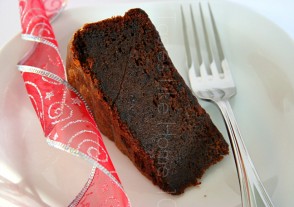Part 2
Hi Everyone, this week, we continue our Holiday Baking Success series by looking at the all-important Christmas cake.
The fruits
The secret to an exceptional Christmas cake lies with the fruits. Prunes, raisins, cherries and currants mixed together with rum, port and Cherry Brandy and left to macerate for an extended period of time. For me, 12 months is the minimum. Not to boast but I even have some 3-year old rum soaked fruits. The long soaking of the fruits allows the alcohol to breakdown the fruits and helps them to truly meld. The alcohol itself ages and develops a more complex and delicious flavour that it gets from lying with the fruits. It is this unique and astounding flavour that is imparted to the cake that makes it one-of-a-kind. When the cake is baked, the blended fruits along with the other ingredients combine to offer a texture that is more pudding like than that of a traditional cake crumb, each morsel of cake revealing layers of flavour and many moments of pleasure.

Now, let’s say that this is the first time you are making the Christmas cake and did not realize that the fruits needed to be soaking for such a long time. No worries I say, but hasten to caution that while you will make a cake, a very enticing cake, the texture and flavour will not be the same as that of a cake whose fruits have been curing for at least a year. So, yes, go ahead and make your cake if you only have what – two-and-a-half weeks before Christmas? You may find the cake a little dry and that is because alcohol, depending on various applications, can dry things out. Because it would not have gotten a long enough period of time to meld with the fruits, the sharp notes will evaporate during baking. I’d like to encourage you at this point to make enough fruits so that you have in time for next year’s stellar cake.
To combat the moisture issue, you can add more blended prunes to the cake mixture. Prunes because they are creamy in texture rather than raisins, currants or cherries.
Jumping ahead, let’s look at whether to ‘feed’ or not to ‘feed’ the cake with a combination of rum, cherry brandy and sherry, when it is finished baking. By feeding I mean, pouring alcohol over the cake after it is baked. Our tradition of feeding the cake harkens to the days of making a traditional English Christmas pudding where the pudding/cake was steamed and made months before Christmas and then fed with rum regularly until the flavours of the pudding/cake were developed. Personally, I do not feed my cake because I don’t have to and because of the high quality of the fruits, due to their yearlong and more maceration, it is never necessary.

If you would like to ‘feed’ your cake, do so while it is still hot. Prick the cake with a skewer or cake tester and drizzle it with a mixture of rum, cherry brandy and sherry. You can do this every hour for at least 12 hours so that the alcohol really gets absorbed into the cake. Or, you can make the cake a week in advance and regularly feed it with the rum-brandy-cherry combo.
Mixing the cake
Mixing the ingredients for the cake together is very easy and straightforward; just follow the directions of the recipe you are using. One of the questions people often ask is what to put into the cake to make it dark, black. Some people put in browning and others use molasses. Use whichever you like based on the recipe you are using. I do not ever put in any darkening agents into my cake; what I do, however, is add more prunes than any other fruits to my blended rum-soaked fruit mixture. The prunes are what I rely on to give my Christmas cake that very dark colour, and yes, it adds to the texture too.
The cake pan
It is important when you read the recipe for the cake you are making that you note the size of pan that is suggested. This is crucial because it will affect the time the cake takes to cook, the yield (height and quantity) of the cake and in some cases the texture of the cake.
Baking pans come in various sizes and shapes. For your Christmas cake you are either going to use a round or square baking pan. And I’m sure that you already have baking pans. To determine the dimensions, always measure the inside edges from one side to the other so that you do not include the outer thickness of the pan in your measurement.
To measure the depth of a pan, take a ruler and measure straight up from the bottom to the top of the pan. Do not slant the ruler if you have a round pan.
To determine the pan’s volume (how much batter it will hold), pour pre-measured water by the cupful until the pan is filled to the brim.
What if you don’t have the exact pan suggested in the recipe? Substitute. The best pan to substitute with is one that allows the same depth (or volume of batter) as suggested in the original recipe.
Baking the cake
When it comes to preparing the pan for the cake, apart from buttering and flouring the pan, I suggest lining the bottom of the pan with either wax paper or parchment paper, this way, the cake will remove easily. You generally don’t have to worry about the sides of the pan because once it is out of the oven and rests for 10 minutes before being turned on to a wire rack to cool, the cake will shrink away from the sides of the pan. If you want to make life really easy, then use a springform pan. You know, those pans where you pull a lever and the sides of the pan are released.
Pay attention to where the recipe instructs that you place the baking rack. For cakes of this type (heavy with lots of fruits and liquid), the baking time is usually longer than most cakes. It is often advised that the baking rack for these cakes be placed in the middle of the oven, this way, the bottom of the cake does not cook faster than the top and the heat circulates more evenly.
The test for doneness is simple. Insert a skewer or cake tester into the middle of the cake and if it comes out clean, the cake is done. Each of us has different ovens – some electric, some gas, some convection, and some convention. And let’s be honest some ovens and stoves just perform better than others. It is for this reason that recipes when written always suggest cooking times, because it varies. Here is how to interpret the timing for doneness of your cake.
If the recipe says, bake for 90 – 95 minutes or until a tester inserted comes out clean, it means the following: The cake should be finished after baking for 90 minutes. So test it at that stage.
If, however, the cake when tested is not done, let it bake for another 5 minutes (making it 95 minutes) and then test it again. If the cake is done at this stage, remove it from the oven, if it is not, then let it continue baking until when you test, the tester comes out cleanly. If after the maximum time given the cake is not done, then check 10 minutes later.
Cooling the cake
Last week, I told you to get yourself some wire racks, also called cooling racks. You are going to need them to place many of your baked goodies to cool.
Let the cake rest in the pan for 10 minutes before removing it from the pan and placing it on the wire rack to cool completely. If you plan to feed your cake, this is the time to start doing so.
Cooling the cake is important because it allows the cake to settle and the interior to become uniform, so that it is easy to cut. If the cake is cut before it is cooled properly, it can crumble.
Storing the cake
Christmas cake can be stored at room temperature. I generally use a large metal cookie tin with a cover. I line the pan and cover with aluminun foil and when the cake is completely cool, I store the cake.
Trust me, you will never have to worry about if you will have a big enough tin to store the cake because by the time it comes out of the oven, all the tortured souls around you who have been enveloped with the aroma emanating from the oven and the kitchen will be itching to get their hands on the cake. You will even have to plead with them to let the cake cool before you cut into it. So, don’t worry too much about storage space.
Next week, we conclude the series with baking the ham. Yum!
If any of your Christmas cake questions or concerns were not addressed in this edition of the column, do not hesitate to drop me a line: Cynthia@tasteslikehome.org
Cynthia




